
Katharina Sieverding. Photograph: Kristian Vistrup Madsen.
by KRISTIAN VISTRUP MADSEN
I am on a rooftop terrace in the middle of Palermo, having dinner with Katharina Sieverding (b1944, Prague, Czechoslovakia) and her partner, the artist Klaus Mettig. Around us, shrieking seagulls compete with football fans gathered for a World Cup match being broadcast in the city’s open squares. I recognise Mettig from earlier series of Sieverding’s, Motorkamera (1973-74), in which portraits of the two merge across countless renditions – Mettig with long hair and in makeup to match Sieverding’s. I first discovered her work a couple of years ago, when I came across the catalogue for her PS1 retrospective in 2004, and was astounded by the boldness of her self-presentation, and the stark acuity of the work, 40 years on. In her images – not exactly photographs – power is materialised in ways that are not purely representational, but have to do with light, layering, time and repetition.
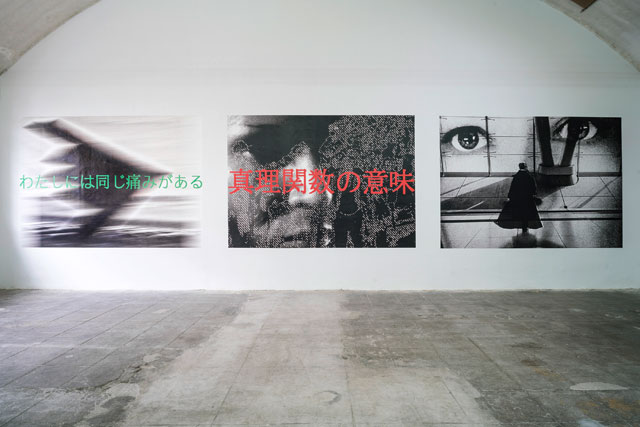
Katharina Sieverding. Installation view, Sieverding Palermo, Manifesta 12, Haus der Kunst, Palermo, 2018. © Katharina Sieverding. Photograph: © Klaus Mettig.
On the rooftop, we are celebrating the opening of an exhibition of Japanese action painting arranged by the veteran Italian curator and critic Achille Bonito Oliva in a nearby palazzo. But, really, our reason for coming together is the show Sieverding – Palermo, due to open the following day at Haus der Kunst. Sieverding knows Bonito Oliva from the 70s, when she had one of the first exhibitions of her career in Rome. She was showing a Kraftwerk-sound-tracked film piece called Life-Death (with her connections in the Düsseldorf club scene, the slightly older, cooler Sieverding had been able to let the young guys in on some fun, so they owed her a favour). In Rome, completely incidentally, and unknown to her, her former professor Joseph Beuys was preparing a show at the same exhibition venue. Sieverding is quick to emphasise how instrumental Beuys was to her early development as an artist. This return to Italy, then, can be said to constitute a type of reunion: with Bonito Oliva and that first time in Rome, and, within the exhibition itself, between work from that time and more recent productions. As always in Sieverding’s practice, however, timelines are folded and distances collapsed. Things are not what they seem, but what she wants them to be.
Kristian Vistrup Madsen: The exhibition in Palermo is book-ended by three series of early self-portraits – selfies, we could call them today – Die Sonne um Mitternacht Schauen (Looking at the Sun at Midnight), from 1973; Stauffenberg-Block (1969); and Transformer Cyan Solarisation (1973-74). Why did you make these works, at that time?
Katharina Sieverding: When I started working in the late 60s, it was very important for me to exhibit these faces as widely as possible, because it was so provocative for most of the art system. People didn’t understand the scale of them – why they’re so big – and this type of abstraction and colour. So, I was trying to test what it means to be so representational as a female artist. It is very important that you start with yourself, and then expand your interest and your view to the globe. The question of identity was, of course, very attractive to me at this time. I had no camera and no studio. I only had tons of passport photos, so they became my primary source of material. Since the beginning of the 60s, I had been working with a theatre, and it was from there that I developed towards the visual arts. I always liked to perform my ideas – one of my ideas being photography, because it allows you to be an absolutely independent producer.
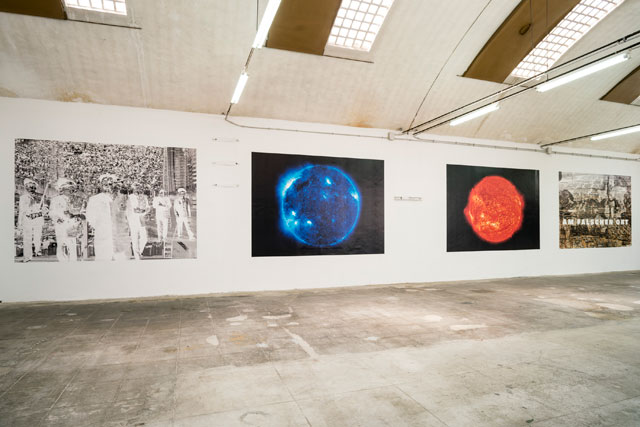
Katharina Sieverding. Installation view, Sieverding Palermo, Manifesta 12, Haus der Kunst, Palermo, 2018. © Katharina Sieverding. Photograph: © Klaus Mettig.
With a photomachine I could do this, I could make these passport photos. While I was making my early films, which cost a lot of money, I was working in nightclubs, and the best one was called Lovers Club. It was in Düsseldorf and it had a photomachine. I taught all my friends to buy their drinks by the bottle and take care of themselves, so I had time to go to this machine and work on my art. That was the beginning. Of course, this whole debate then about discriminating facts such as age, sex, race, class and so on, I tried to integrate in the work, with its size, with the closeup and the transformation that takes place across a series. A main point for me was to liberate photography completely in order to find out what other kinds of artistic potential that medium contains. For me, there were no rules, nothing. I never learned about photography, but I think that was the best way. When I saw something in movies or in magazines that I liked, I would rephotograph and use it. So, reproduction was always very important for me, and that was in a time when photography, in a classical sense, was becoming very prominent. This other school in Düsseldorf …
KVM: Yes, your relationship to photography is very different from that of the Düsseldorf School – Bernd and Hilla Becher and those who studied with them in the 70s, such as Candida Höfer and Thomas Ruff. Your work sets out to debunk the myth of the darkroom, and how the photograph is technically produced. It’s totally opposite to their idea of photographic objectivity. Rather, you are working with performativity and an almost wilful deception.
KS: You know, what they did was canonise photography. But I started in 1967 with Joseph Beuys, which was a completely different space to work in. I never understood what the Bechers were doing and, to this day, I don’t have an interest in the history of photography. Still, I really wanted to work with this medium, because of my interest in reproduction. So, I started somewhere completely different, at the other end of the spectrum, from manipulation. But when you take an image and blow it up into a big form, you still really have to use technology. For this reason, I also love this whole new digital century. I trained a lot to work with fake news, and how you’re able to alter images. In a way, I also make fake news. I’m completely free. My work has been a process of emancipation from the boundaries imposed by histories and media.
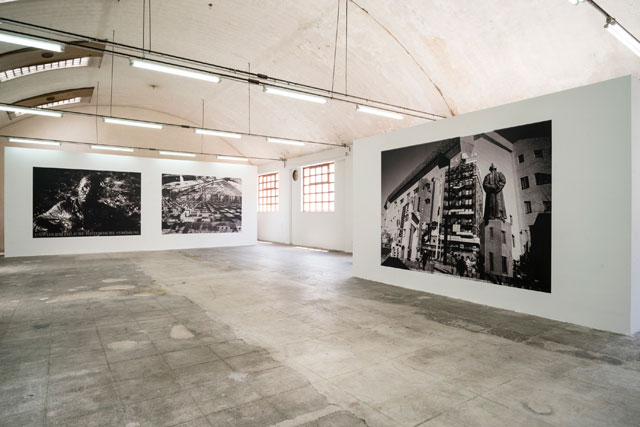
Katharina Sieverding. Installation view, Sieverding Palermo, Manifesta 12, Haus der Kunst, Palermo, 2018. © Katharina Sieverding. Photograph: © Klaus Mettig.
KVM: I’m interested in the connection between these early works in the exhibition and the later ones, where you moved away from using your own portrait. For me, it has to do with repetition and seriality. The closeup of your face, when repeated, becomes a kind of defacement. Even if there was never a face in the picture, a similar type of abstraction is produced either by the work being made by layered appropriated images, or it being copied and shown in many places at once. Perhaps this is what you called starting with yourself and then expanding your interest to the globe – quite literally in this series, named after the previous one, Looking at the Sun at Midnight SDO/NASA (Red)/(Blue), 2011-3. How did they come about?
KS: Yes, these works represent a continuous move away from the self-portraits. Since the 80s, I’ve been interested in radiation and nuclear stuff, and have been using these ideas from Henri Becquerel and Marie Curie. I think it is an important theme to address in the arts, but you cannot paint it – you need technology. That brought me to the sun, the blue sun. During my research, some expert told me: you have to imagine the sun through the Earth. You go into meditation and you go through the Earth to imagine the other side. I thought that was a great idea. When thinking about the sun through the Earth, you cover all phenomena of exploitation, natural resources and so on. Usually, we are only interested in our own position in relation to the sun – a strictly human, existential relationship – and we look at the sun like this: red and yellow. So, of course, I thought: it must be blue. Many people think it’s planet Earth. I phoned Nasa and asked it to send more high-res data, and one day – it was in May 2010 – it uploaded 4K images, and I started to download them every day.
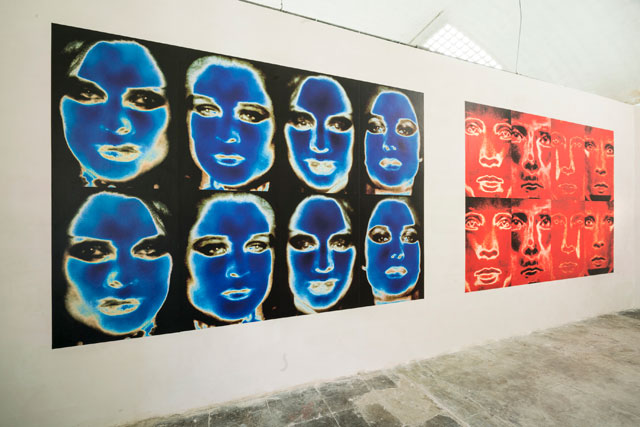
Katharina Sieverding. Installation view, Sieverding Palermo, Manifesta 12, Haus der Kunst, Palermo, 2018. © Katharina Sieverding. Photograph: © Klaus Mettig.
KVM: Compositionally, they are really similar to the selfies. What appears to be about identity is actually about how identity evaporates; how it dissolves into this universal thing. As you zoom in on the face, the context disappears, and it becomes a work about non-identity, about deterritorialisation.
KS: Every identity, you have to work on – it’s always changing. This is the meaning behind the work: you have to construct it. The idea that everyone has such and such an identity is all a political construction.
KVM: In 1993, you participated in a poster campaign in response to xenophobic violence in Germany. The project was called I AM YOU, which is a strange title, because, obviously, xenophobic violence happens because I am not you. In that context, it could sound somewhat naive, but what I like about your contribution is that it dissolves the notions of I and You into a sense of general uncanniness. It pans away from individual identities to address the ramifications of collective ones.
KS: In this poster, I combined an image of a mass ornament, the backs of a group of heads –mass society, or masses in society, as an ornament in itself – with these three titles: Geistesleben, Wirtschaftsleben, Rechtsleben [Spiritual Life, Economic Life, Judicial Life]. I had these photographs of mass ornaments from the times we were in China – we got a visa for the first time in 1978. In Maoism, they used mass ornaments as a kind of advertisement to make everyone think the same. I applied this threefold separation, which, in the end, is organised around Economic Life. This is an old idea. With I Am You, I was thinking: what constitutes an I and a You; how do we avoid economising these other areas of our lives?
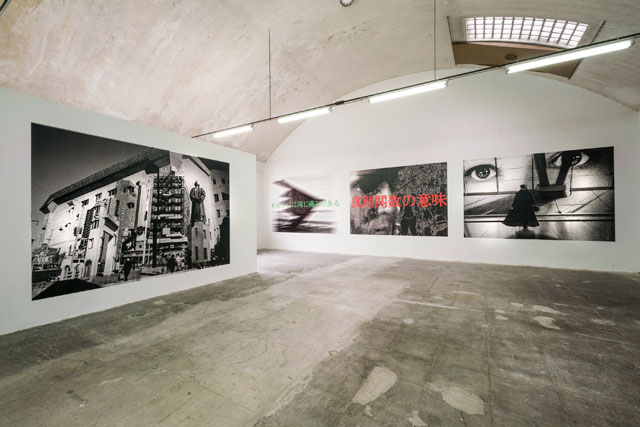
Katharina Sieverding. Installation view, Sieverding Palermo, Manifesta 12, Haus der Kunst, Palermo, 2018. © Katharina Sieverding. Photograph: © Klaus Mettig.
KVM: The concept of the mass ornament was first used by Siegfried Kracauer about the Weimar Republic. Why did these images from China resonate with you in the context of Germany in 1993?
KS: In Germany, we also had these mass ornaments during fascism, but also in communism and in Maoism, there is a pull to make people think the same way. After the reunification of Germany and the fall of communism in the east, and the violence that followed, it became very relevant to think about the construction of collective and national identities.
KVM: Speaking of the legacy of fascism in Germany, in the work Encode VII (2006), we see a camp structure combined with Peter Eisenman’s recognisable Memorial to the Murdered Jews of Europe in Berlin.
KS: I was asked to make a proposal for a Sinti and Roma memorial, so I had a chance to think about these things and did a lot of black-and-white photographic documentation. But I didn’t participate in the end, because Eisenman’s memorial irritated me. As part of my research, I drove to Sachsenhausen, a concentration camp near Berlin. When you enter, there is a little model in bronze that I took this photo of. The site was organised around a centre from which they could look down every street of the camp for absolute control. In layering these two images, I wanted to draw a parallel to the similar linearity of the memorial in Berlin. I’m still irritated by it: I mean, what does it tell us? Children should not play, or eat pommes-frites, or whatever. All activity is wrong there, somehow, and it has to be kept clean like a cemetery. What does art or a memorial mean to what happened, and what the Germans did? When I made this other work in Berlin, Deutschland wird Deutscher [Germany is becoming more German] (1992), there was such criticism: “How can she make such a statement?” I think the Germans are still not really able to overcome the fascism.
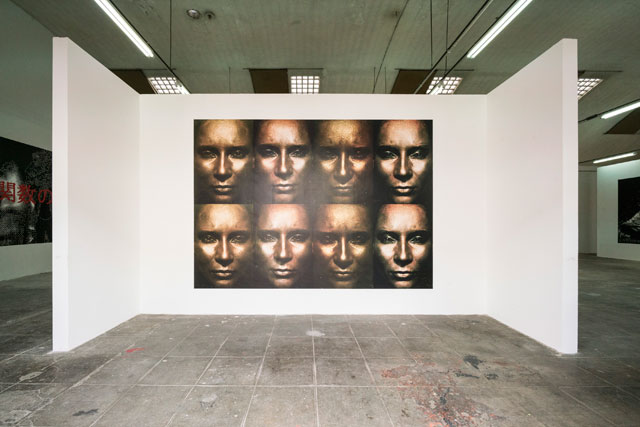
Katharina Sieverding. Installation view, Sieverding Palermo, Manifesta 12, Haus der Kunst, Palermo, 2018. © Katharina Sieverding. Photograph: © Klaus Mettig.
KVM: In the exhibition, Encode hangs right next to an older work, Unwiderstehliche Historische Strömung [Irresistible Historical Current] (1979). In that context, I can’t help but think of the scandal around the Eisenman memorial: that the anti-graffiti chemical the stones are covered in is produced by the same company that made the lethal gas used in the death camps. There is such relentlessness to fascism, such recalcitrance to its imprint on society, that even the antifascist memorial is tainted by it. That memorial is so abstract, completely non-figurative, where this adjacent poster is dominated by a character emerging from the ground.
KS: It’s a still from Charlie Chaplin’s film The Great Dictator from 1940.
KVM: The new work, Global Desire II: Am Falschen Ort [In the Wrong Place] (2017), has a similar composition to Encode: two images, overlaid, a kind of landscape.
KS: I made it for the regional election in Düsseldorf, where it hung in many places all over the city. Am Falschen Ort is the title of Edward Said’s biography. I made the work at the time of the Russian intervention in Syria, and so, inspired by that conflict, took this aerial photo of the biggest concentration camp, which housed almost 100,000 people. The poster hung in the same billboard size all over the city during the North Rhine-Westphalia elections to make people think about what the German politicians are doing. First Merkel said: “We can do it”, but now it’s a disaster, and they want to build these camps. Are we really building new camps? Will we concentrate the migrants, again, in camps? You know what I mean?
KVM: And why did you use the title from Said’s biography?
KS: Throughout his life, Said always felt displaced, and he describes that in the book. My idea was that, if we continue like this, the idea of displacement expands. Somehow, everyone, even if you live in a gated community, is in the wrong place.
KVM: With the poster being in so many places in the city, which place is the wrong place? And in which ways is Germany the wrong place for certain things to happen? It’s such an open statement. I’m interested in this other work from the Encodeseries, No XIV (2006). All the works have this cinematic quality, but this one really seems to exist in a fictional universe. There is a way in which this pervasive “wrong place”, in this piece, becomes a “no place”.
KS: This work began with a photograph I took of a person with a black coat walking down Brunnenstrasse in central Berlin.
KVM: That’s the street where I live!
KS: Really? Well, I wanted to see him from the front, but he was too fast, so I lost him. And then, when I saw the photograph from the back, I thought: “I want to meet him!”, so I composed this encounter. In this image, we are walking towards one another, me in the sunglasses at Frankfurt airport.
KVM: It’s funny that it could have been me, and here we are: It’s as if your fake-news meeting came true!
• Sieverding – Palermo, part of Manifesta 12 is at Haus der Kunst, Palermo, until 4 November 2018.